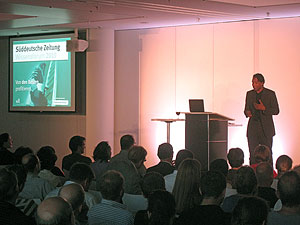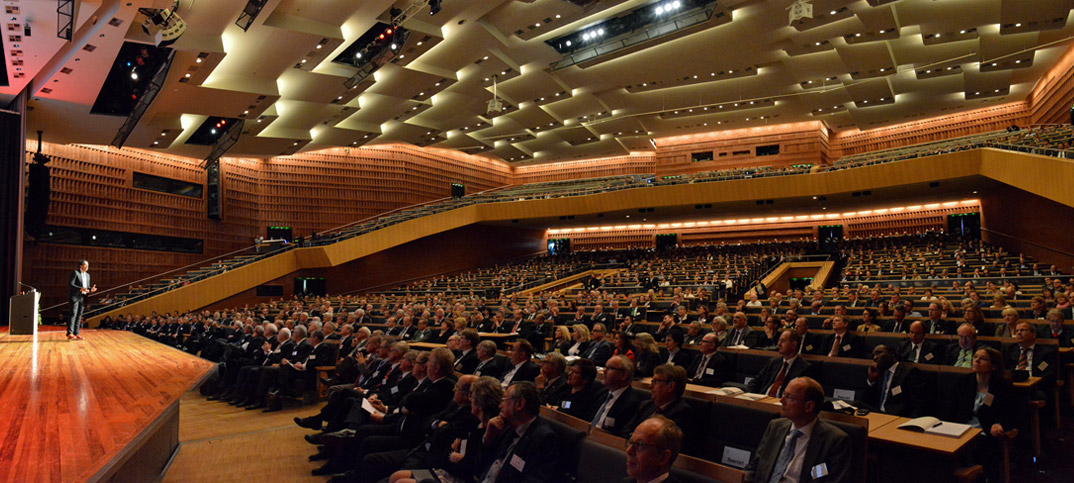Speaker Cherno Jobatey

Whether the venue is a major arena or a small stage, to Cherno Jobatey delivering speeches is completely different from television with its millions of viewers: alone on stage with his manuscript – with minimal technical aids – facing an audience of 400 to 500. Unlike at home, lecture halls are not equipped with remote controls to change channels, but on stage you notice immediately when energies are diverted elsewhere. Therefore, it is not enough to have mastered the content, it must be “delivered”.
Speeches are different
Even if there is a book, an article, or a whole website on a subject, following a speaker live is a completely different animal: the listener experiences the dramaturgical arc of tension and has the opportunity to ask questions afterwards.
The Fred Astaire Rule
 Cherno Jobatey’s presentations are frequently about communication, politics or business. Here too, however, there is a golden rule: every stage personality – musicians, actors or speakers alike – has internalized the words of the Hollywood legend Fred Astaire: “The hardest thing is to make it look so easy.” It was first noticed in pop music: those who have mastered their art live are in demand.
Cherno Jobatey’s presentations are frequently about communication, politics or business. Here too, however, there is a golden rule: every stage personality – musicians, actors or speakers alike – has internalized the words of the Hollywood legend Fred Astaire: “The hardest thing is to make it look so easy.” It was first noticed in pop music: those who have mastered their art live are in demand.
Commenting on his successful lecture Digital Power, a reporter wrote: “In his usual, casual style, Cherno Jobatey spoke about online communication. … During his lecture before 500 guests, he described the Obama phenomenon in highly comical terms, getting many laughs” (HAZ). Cherno Jobatey is “somebody who works hard for his success”. (Berliner Morgenpost)
Speech: Digital Power. The Quiet Revolution
 Anyone with anything to say or to sell today is quick to notice that the power balance in the struggle for opinion leadership has shifted in favor of those who make use of the opportunities offered by the new era.
Anyone with anything to say or to sell today is quick to notice that the power balance in the struggle for opinion leadership has shifted in favor of those who make use of the opportunities offered by the new era.
Supply and demand meet virtually; filters such as Google bring together market participants. Where there used to be only one path to the customer, today one is well-advised to have mastered three:
1. The customer comes directly (coincidentally or consciously).
2. The customer finds you via search engine because the information provided corresponds to its criteria.
3. The customer comes because the product has been recommended, possibly via social media.
This lecture provides an insight into new strategies for the today’s struggle for the prerogative of interpretation. The focus is on companies such as Coca-Cola, HP, Dell and Honda. It provides an introduction to topics such as search engine optimization (SEO), search engine marketing (SEM), aggregation, and curation. It also discusses the costs of this new attention economy, best practice examples, finding appropriate campaign topics, and the simulation of an implementation.
Since the mid-1990s there has been a gradual, subtle change in this field of public relations: while the world was busy with several wars in the Gulf area, the Middle East and the Balkans, a quiet revolution was taking place which has changed the world more profoundly than many realize. It became clear to most people only when a political nobody from the Midwest, from Illinois, ran for the office of President of the USA, and actually won.
Speech: Digital Business Communication
Once upon a time, communication was quite manageable: with the help of media companies, the masses could be reached through these outlets’ articles and stories, or “on the side”. Circulation was bought from their advertising departments at the corresponding price. The business of attention was clearly defined and demarcated. Given the large sums necessary to advertise oneself or one’s ideas, many were excluded.
Product communication has changed considerably. New methods enabled new products to enter the market, and established ones to observe new market participants with astonishment. The worldwide bestseller 50 Shades of Grey by E. L. James originated as a blog in a teen e-publishing community in Australia. Derided as “mummy porn” and almost universally disparaged by reviewers, the work rose to the top of the New York Times e-book and print bestseller lists, mainly with the help of social media. A million-dollar publishing contract followed. The auction of the film rights was one of the biggest Hollywood has ever seen.



